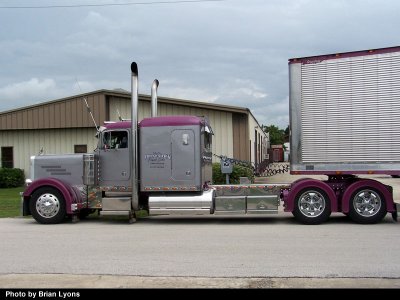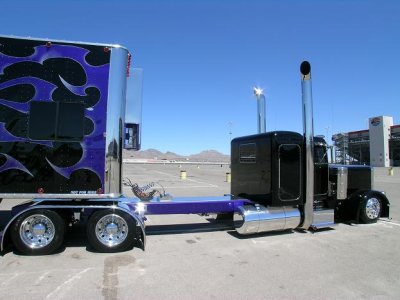When I’ve seen a cab-over being serviced, it doesn’t look more difficult. You tip the cabin over, then the entire engine/gearbox is exposed out there in front of you at bench level. No reaching down, or up, or around.
Since we have some truck experts here, another question: I’ve noticed some super long wheelbase semi tractors. They have sleepers but there’s a big gap behind the sleeper to the hitch. What are those about?
This cite says:
If the truck is spec’ed well, regarding front axle turning radius, the advantages of a 280 long wheelbase are improved ride and improved swing/dip radius (the distance from truck to trailer).
This increased radius improves the ability to maximize your weight allowance on the steering axle. The extra frame rail length also allows room to mount generators or tool boxes.
I can see the reduced weight on the steering wheels but don’t understand how the ride is improved (or why that is justified over what must be increased cost) or what a swing radius is. I’ve only seen them on what seem to be owner-operated rigs and, if I didn’t know better, I’d guess it was for the sake of appearance.
Here’s one that even more exaggerated than most:
Unless you want to crane out the entire unit?
With the cab-over design that tips forward, all of the connections between the cab and frame must have provision for flexibility: steering, brakes, gearshift, electrical connections, heating and cooling…
Not impossible, but just another level of complexity.
See this Wikipedia page: Semi-trailer truck - Wikipedia
Almost half-way down the page is a picture of a “Tractor unit hauling tractor units”. The long frame allows the tractor in the middle to be carried without scraping the frame. There are probably other reasons that the long frame offers an advantage. Does anyone know if certain trailers are built to cantilever forward over the hitch?
Putting your kid on a school bus with a thin roof and no seat belts is already safer than driving your kid to school in your own car. School buses don’t roll over very often, and in a collision with a car they have a massive (no pun intended) weight advantage. The benefits of adding seat belts and a tougher roof are not enough to justify the added cost.
European school buses, which are just regular coaches and not specially designed, are all fitted with seat belts.
Getting the kids to use them however…
Not so far down is “Euro-Combo variants”, with F showing why the manufacturers make long wheelbase tractors.
The advantage is the increased weight on the steering wheels. Road rules limit the weight that can be on the steering wheels, but also limit the weight that can be on the trailing wheels – so, up to the legal limit, increased weight on the steering wheels gives you increase load capacity as well as increased control capacity. I can’t see that as being an important factor for a tractor that long – if you want increased load on the front wheels, you move the turntable further forward. Increased load on the steering wheels is particularly important on bad roads.
The ‘swing radius’ just means you double back alongside the trailer without the front of the load running into the back of the cabin, and the ‘dip radius’ just means you can run through a dip without the top of the load hitting the back of the cabin. Again, the reason for a really long tractor is that the chassis was built for a truck body.
Ride is improved because the action of a short wheelbase is choppy. With a longer wheelbase there is less pitch.
The fifth wheel (or turntable, if you like) isn’t any further forward in the ones I’ve seen, though.
From your description, I now understand the radius definitions and I’m sure that’s a big problem in some applications. However, most of the long tractors I’ve seen simply don’t have this problem. And they won’t have this problem as they’re always hauling the same trailer. I can be pretty certain since the trailer matches the tractor.
Check these two:


These drivers aren’t dropping the trailer and picking up another.
I’m arriving at the conclusion that it’s simply for appearance reasons.
Wait, you guys have seatbelts on your school buses over there…? All the school buses I’ve been on (in the US) have no seatbelts (except for the bus driver). Guess they don’t really care about the kids’ safety here…
It’s optional in my town (melb.vic.au). It’s not enforced by the state, because they know it’s a stupid rule that just adds cost. There are parents who are poor enough that a rule adding cost without benefit could exclude their kids from activities. It’s enforced at the local school level, because if the costs don’t matter to the parents, who cares if it’s a rule without benefit?
I don’t remember if there is a rule for rural/excursion school buses, where the hazards are different.
A couple of notes: cabovers were much more common in the US in the 1960s and 1970s, as they allowed longer trailers without hitting the 65-foot limit on overall vehicle length. In 1976, that limit was increased to 75 feet and the need for cabovers diminished. I think all cabovers required tilting the driver compartment forward to access the engine.
“Transit bus” type school buses are very unusual in the US—except in California. That state has special crashworthiness standards for school buses, necessitating special models. Crown Coach and Bluebird were historically the primary builder of California school buses. I’m not sure just why they used different chassis or jigs that were better suited to flat-front bodywork.
No, there are no seat belts in typical school buses in Germany (which are usually normal “city” buses; there are no distinct school buses over here). Seat belts are, however, mandatory in long distance coaches and it is mandatory to use them on long-distance journeys. If coaches get used as school buses or in normal short-distance public transport (which happens at times, mostly in rural areas) is, however, not mandatory to use the seat belts.
Disclaimer: This is valid for Germany and will probably not reflect law as well as actual practice in other European countries.
My middle school bus had seatbelts, but high school didn’t. I walked to elementary school so I don’t really know what that bus had. This was Illinois in the 1990s, and elementary/middle schools were different districts than the high schools, thus they could have different policies. It was also the case that the school district(s) owned the buses, and the drivers were usually school janitors. Nowadays it seems more likely that both those jobs/services are contracted out, so the decision about seatbelts probably isn’t directly under the purview of the school district anymore.
I used to drive school busses. (CA) It’s been a long time since I have, but I remember a few things about passenger safety.
Seat belts, in addition to the expense and hassle of getting the kids to wear them, had other disadvantages. In the words of my supervisor, “Can you imagine an angry teenager armed with a seat belt buckle?”
The driver has a seat belt so they don’t get thrown into the door well during a sharp left turn. If it’s a flat front bus, you’re sitting in front of the front wheels. It’s at the far end of the vehicle swinging around a corner. Odd feeling.
Also, the seats are designed as little padded cubicles to keep the passengers contained and safe in case of an accident. The seat backs are very high and padded on the back and top edge. Bus gets in an accident and the passengers rattle around in their little padded box. The old busses had a steel tube across the top and metal backs on the seats. Very dangerous. They got rid of them.
Just as an aside, I drove in the 1980s. Standards and laws have undoubtedly changed a lot since then. I trained in a 1955 Crown coach somewhere around 32 feet long. It had no power steering- we called it “Armstrong Steering”- and you had to double clutch to change gears. It was a beast, but it still got used as a back up vehicle occasionally. If you could drive that, you could drive anything else in the yard.
Not true. COEs were still in production well into the 90s.
It’s been the law for semis in CA since I think 2009-ish to have them. That’s why you see so many - you can’t deliver to CA if you don’t.
You got it. “Cool” is the rule. Now, the driver will regret his long frame if he delivers in residental Brooklyn or such, but it doesn’t come up that often.
Cool. I did not know that. Thanks. I’ve lived in the eastern half of the country since '94, and skirts are common, but far from universal here.
Magnificent machine.
The school I’m working at has several different models of school bus, some with flat fronts and some with noses. I imagine that they bought them one at a time, as needed, and each time just got whatever was cheapest or most easily available.
Still, around here (urban), most school buses still have noses, and most public transit buses have flat fronts, even in the same environment. And the greater visibility advantage of the flat fronts, you would think would be an even bigger issue for school buses. So why are school buses and transit buses different?
Cool. I did not know that. Thanks. I’ve lived in the eastern half of the country since '94, and skirts are common, but far from universal here.
Here in AZ, so close to CA, I think every truck has them.
Magnificent machine.
I’m always pleasantly surprised when I see a COE on the road. There are a few, probably all owner-operators. And farmers - they still have them because they make cheap grain trucks. This is an '84.

